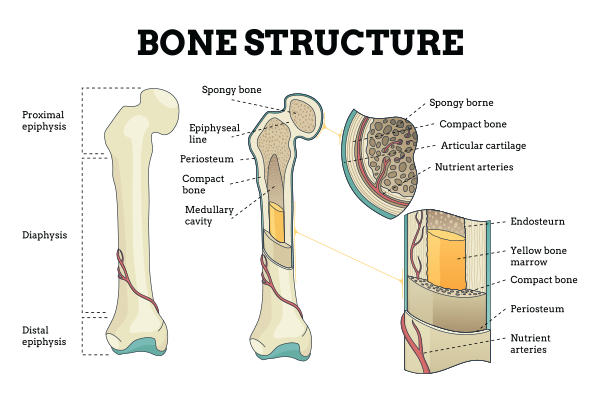
Listen to article
Loading audio...
Bones are the foundation of our body, providing structure, support, and protection to vital organs. However, like any other part of the body, bones can develop issues over time, leading to discomfort, mobility problems, and serious health complications. Understanding common bone diseases can help in early detection and effective treatment.
In this blog, we’ll explore various bone disorders, their symptoms, prevention methods, and treatment options. Whether you're experiencing joint pain, mobility issues, or have a family history of bone marrow problems, this guide will help you take proactive steps toward healthier bones.
Synopsis
Common Bone Disorders and Their Symptoms
Bone disorders can be caused by genetic factors, ageing, lifestyle choices, or underlying medical conditions. Here are some of the most prevalent ones:

1. Osteoporosis
Osteoporosis is a condition that weakens bones, making them more prone to fractures. It occurs when bone density decreases due to ageing, hormonal imbalances, or calcium deficiency.
Symptoms:
-
Frequent fractures (especially in the spine, hip, or wrist)
-
Back pain due to vertebral fractures
-
Loss of height over time
Prevention & Treatment:
-
Increase calcium and vitamin D intake
-
Engage in weight-bearing exercises
-
Medications like bisphosphonates may be prescribed
2. Osteopetrosis
Unlike osteoporosis, osteopetrosis is a rare genetic disorder in which bones become overly dense, making them brittle and susceptible to fractures.
Symptoms:
-
Frequent fractures
-
Delayed growth in children
-
Bone marrow failure (leading to anaemia and infections)
-
Prevention & Treatment:
-
Bone marrow transplant for severe cases
-
Calcium and vitamin D regulation
-
Medications to manage symptoms
3. Hypophosphatasia
Hypophosphatasia is a rare metabolic disorder affecting bone and tooth development due to defective mineralization.
Symptoms:
-
Premature loss of teeth (especially in children)
-
Soft, weak bones lead to fractures
-
Respiratory issues in infants
-
Prevention & Treatment:
-
Enzyme replacement therapy
-
Proper nutrition and vitamin supplements
-
Regular monitoring by an orthopaedics specialist
4. Paget’s Disease of Bone
Paget’s disease disrupts the natural bone remodelling process, leading to enlarged and deformed bones.
Symptoms:
-
Bone pain
-
Deformities in the affected bones
-
Increased risk of arthritis
-
Prevention & Treatment:
-
Regular exercise
-
Bisphosphonate medications
-
Pain management strategies
5. Osteomyelitis (Bone Infection)
This is a bacterial or fungal infection of the bone, usually caused by injury or surgery.
Symptoms:
-
Swelling and redness in the affected area
-
Fever and chills
-
Severe bone pain
-
Prevention & Treatment:
-
Antibiotics or antifungal medications
-
Surgery to remove infected bone tissue
-
Proper wound care and hygiene
Summary Table of Common Bone Disorders
|
Bone Disorder |
Symptoms |
Prevention & Treatment |
|
Osteoporosis |
Frequent fractures, back pain, height loss |
Calcium & vitamin D, exercise, and medication |
|
Osteopetrosis |
Brittle bones, delayed growth, anaemia |
Bone marrow transplant, calcium regulation |
|
Hypophosphatasia |
Weak bones, early tooth loss, and respiratory issues |
Enzyme therapy, vitamin supplements |
|
Paget’s Disease |
Bone pain, deformities, and arthritis risk |
Exercise, bisphosphonates, and pain management |
|
Osteomyelitis |
Swelling, fever, severe bone pain |
Antibiotics, surgery, and proper wound care |
How to Prevent Bone Disorders?
Maintaining bone health is crucial to preventing bone disease symptoms and ensuring long-term mobility. Here’s how you can protect your bones:
1. Balanced Diet
-
Include calcium-rich foods like dairy products, leafy greens, and almonds.
-
Get enough vitamin D from sunlight, fish, and fortified foods.
2. Regular Exercise
-
Engage in strength training and weight-bearing activities like walking, running, or yoga.
-
Maintain a healthy weight to reduce pressure on bones.
3. Lifestyle Modifications
-
Avoid smoking and excessive alcohol consumption.
-
Get regular health checkups, especially if you have a family history of common bone diseases.
How Aging Affects Bone Health
4.1 Why Bones Weaken with Age
As we age, our bones naturally lose density due to decreased calcium absorption, hormonal changes, and slower bone regeneration. This leads to an increased risk of fractures and osteoporosis.
4.2 Strategies to Maintain Bone Strength in Older Adults
-
Increase Calcium and Vitamin D Intake: Ensure adequate daily intake to support bone density.
-
Engage in Weight-Bearing Exercises: Activities like walking, resistance training, and yoga help maintain bone strength.
-
Monitor Bone Health Regularly: Get bone density scans and consult an orthopaedics specialist for early detection of issues.
-
Prevent Falls: Install safety measures at home, use supportive footwear, and improve balance with exercises.
4.3 Common Misconceptions About Bone Aging
-
Bone loss is inevitable and cannot be prevented – While some loss is natural, a healthy lifestyle can slow the process significantly.
-
Only women are at risk of osteoporosis – Men can also develop osteoporosis, particularly after age 65.
-
Milk is the only source of calcium – Other sources like leafy greens, almonds, and fortified foods provide ample calcium.
Conclusion: Take Charge of Your Bone Health
Bone disorders can impact daily life, but early detection and proper care can make a difference. If you or a loved one is experiencing bone marrow problems or other common bone diseases, don’t wait—seek medical guidance now.
At Manipal Hospital Kharadi, our orthopaedics speciality provides world-class diagnostics and treatments to help you maintain strong, healthy bones. Book an appointment today and take the first step toward better bone health!
Schedule a Consultation at Manipal Hospital Kharadi.
FAQ's
The early signs include persistent bone pain, frequent fractures, stiffness, swelling, and mobility issues.
You can improve bone density by consuming calcium and vitamin D, exercising regularly, and avoiding smoking and excessive alcohol.
Some bone diseases like osteopetrosis and hypophosphatasia have genetic links, while others result from lifestyle factors.
Limit processed foods, excessive salt, and carbonated beverages as they may reduce calcium absorption.
If you experience chronic bone pain, fractures without trauma, or any unusual bone disease symptoms, consult a specialist immediately.



















 5 Min Read
5 Min Read


















